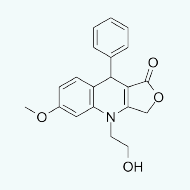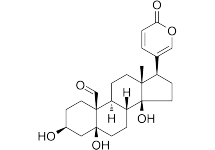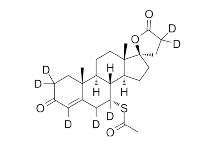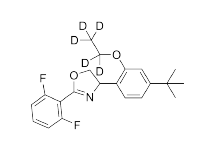 |
| MedChemExpress (MCE) offers a wide range of high quality research chemicals and biochemicals including novel bioactive compounds, dye reagents, peptides and natural compounds for laboratory and scientific use. |
| • Over 100,000 bioactive molecules in stock |
| • Target 1,000+ key proteins in 20+ signaling pathways |
| • Quality reports (LC/MS, NMR and HPLC) for each product |
| • Release more than 1,000 latest biochemicals per month |
| • Data sheet with detailed biological information |
| • High purity & competitive prices |
| • Delivery within 24 hours |
|
|
CAS No.: 2648986-65-4
|
|
|
|
|
Research Area: RIOK2/Cancer
|
 |
| • |
A selective and high-affinity RIOK2 inhibitor with a Kd value of 6.1 nM. |
| • |
Exhibits potent proliferation inhibition activity against multiple cancer cell lines and demonstrates anti-tumor effects in mouse xenograft models. |
|
|
|
Solubility: DMSO: 12.5 mg/mL (23.97 mM; Need ultrasonic)
|
|
|
CAS No.: 1629908-92-4
|
|
|
|
|
Research Area: GBP1:PIM1 Interaction/Ovarian Cancer
|
 |
| • |
A potent guanylate binding protein 1 (GBP1) and PIM1 interaction inhibitor with a Kd of 38 nM. |
| • |
Inhibits proliferation of Paclitaxel resistant cancer cells. |
| • |
Stabilizes a conformation of GBP1 not suitable for binding to PIM1. |
|
|
|
Solubility: DMSO: 62.5 mg/mL (185.26 mM; Need ultrasonic)
|
|
|
CAS No.: 27430-18-8
|
|
|
|
|
Research Area: Phosphodiesterase (PDE) Tdp1/Breast Cancer
|
 |
| • |
A specific tyrosyl-DNA phosphodiesterase (PDE) 1 (Tdp1) inhibitor with an IC50 value of 0.71 μM. |
| • |
Enhances the sensitivity of MCF-7 cells to Camptothecin, increases DNA breaks, and reduces cell proliferation. |
|
|
|
Solubility: DMSO : 12.5 mg/mL (56.25 mM; Need ultrasonic)
|
|
|
CAS No.: 31993-01-8
|
|
|
|
|
Research Area: mGluR/Neurological Disease
|
 |
| • |
A highly selective mGluR5 antagonist with an IC50 of 0.4 μM for human mGluR5. |
| • |
Non-competitively inhibits Glutamate-induced increase in Ca2+ at hmGluR5 with an IC50 of 0.29 μM. |
| • |
Shows neuroprotective and anti-hyperalgesia effects in animals. |
|
|
|
Solubility: DMSO : 12.5 mg/mL (58.62 mM; ultrasonic and warming and heat to 60°C)
|
|
| MegaUni Diversity Library |
|
|
|
| MCE MegaUni compound library is AI-powered diversity library. Compounds in these libraries have most favorable molecular properties with novelty, drug-like properties, diversity, and synthesizability. |
 |
| Flowchart of MegaUni Diversity Library |
| Cat.No. |
Product Name |
Size |
Description |
| HY-L912V |
MegaUni 10M Virtual Diversity Library |
10,000,000 |
A unique collection contains 10,000,000 synthetically accessible screening compounds for the novel lead identification. Easy to synthesize via standard 1-2 step procedures. |
| HY-L910V |
MegaUni 50K Virtual Diversity Library |
50,000 |
A novel collection of synthetically accessible, lead-like compounds of exceptional structural diversity. Easy to synthesize via standard 1-2 step procedures. |
|
|
| |
| Bufadienolides Against Cancer |
|
|
|
| Bufadienolides are a class of polyhydroxy steroids with an α-pyrone ring at the C17 position. And they are also the active constituents of the traditional Chinese medicine ChanSu (Venenum Bufonis) and cinobufacini injection. Bufadienolides exhibited significant in vitro anticancer activities against human myeloid leukemia cells, hepatoma cells, lung carcinoma cells, gastrointestinal cancer cells, and so on. |
| Structure |
Product Name |
CAS |
Description |
 |
Hellebrigenol |
508-79-2 |
A metabolite of bufadienolides with antitumor activity. |
 |
Hellebrigenin |
465-90-7 |
Inducing DNA damage and cell cycle G2/M arrest and triggering mitochondria-mediated apoptosis. |
 |
Arenobufagin |
464-74-4 |
A bufadienolide from toad venom with anti-cancer activity. |
 |
Gamabufotalin |
465-11-2 |
Widely used in cancer research, inhibiting angiogenesis by inhibiting the activation of VEGFR-2 signaling pathways. |
 |
Cinobufagin |
470-37-1 |
Inducing the cell cycle arrests in the G1 phase or G2/M phase, leading to apoptosis in cancer cells. |
|
|
| |
| Anti-Hematopathy Compound Library |
|
|
|
Hematopathy, also known as hematopoietic system diseases, are a class of diseases that hematopoietic system has abnormal changes. Common hematopathy include: aplastic anemia, myeloproliferative diseases, thalassemia, leukemia, lymphoma, myeloma and hemophilia, etc. In recent years, treatments for hematopathy have been developed. In particular, the treatment of malignant hematopathy developed from chemotherapy, radiotherapy, bone marrow development to immunotherapy, induced differentiation therapy, cell therapy, gene therapy and hematopoietic stem cell transplantation. Although these therapies have greatly improved the survival rate of patients, there are still problems such as low cure rate and easy recurrence in the treatment of hematopathy. Therefore, it is of great significance to actively search for new hematopathy therapeutic drugs.
MCE designs a unique collection of 2500+ anti-hematopathy small molecules, which is an effective tool for development and research of anti-hematopathy compounds. |
|
| |
| Anti-Ovarian Cancer Compound Library |
|
|
|
Ovarian cancer is a cause of death in female genital malignancies, with the highest mortality rate in female genital malignancies. It is characterized by difficulty in detection in the early stage of the disease, high recurrence rate and poor prognosis. In fact, ovarian cancer includes many pathologic types. It is usually divided into epithelial ovarian cancer, malignant germ cell tumors and sex cord stromal tumors, of which epithelial ovarian cancer is the most dominant form. Clinical treatment of ovarian cancer prioritizes surgery combined with paclitaxel chemotherapy. However, due to the spread and drug resistance of tumor cells, the recurrence of ovarian cancer is high. In this case, combined with traditional methods, the development of new therapeutic agents can help to improve the treatment effect of ovarian cancer.
MCE designs a unique collection of 1700+ compounds with definite or potential anti-ovarian cancer activity, which mainly targeting the main targets of ovarian cancer such as PARP, ATM/ATR, VEGFR and HIF/HIF Prolyl-Hydroxylase, etc. It is an essential tool for development and research of anti-ovarian compounds. |
|
| |
| MCE Isotope-labeled Compounds |
|
|
|
|
|
|
Latest Publications Citing Use of MCE Products |
 |
Nature.
2023 Feb;614(7949):774-780. |
Nature.
2023 Dec;624(7991):425-432. |
Nature.
2023 Dec;624(7991):442-450. |
Cell.
2023 Dec 7;186(25):5606-5619.e24. |
|
 |
|
|
Products are for research use only and are not intended for human use. We do not sell to patients.
We respect your privacy and do not share or sell your information to third parties. |
|


 検索
検索


















